If you are looking for things to do in Epernay, France, the chances are they are going to have something to do with everyone’s favorite sparkling beverage – champagne! Epernay is called “The Capital of Champagne,” and is home to many prestigious champagne houses. A visit will provide a beautiful, bubbly experience you won’t forget.
Where is Champagne?
The Champagne Region of France is located in the northeast of the country. It is about 62 miles (100 kilometers) east of Paris. The region as a whole is about the size of the state of Maryland in the US, measuring 13,000 square miles (34,000 square kilometers). It contains more than 84,000 acres (34,000 hectares) of vineyards, making it one of the largest wine-producing regions in France – and definitely my favorite!

Visiting the Champagne region of France is a dream. This land of rolling hills and picturesque vineyards, red poppies and church steeples, looks like a landscape straight from the canvas of Monet. And it’s the only place in the world that can call its sparkling wine “champagne.” But this region is more than just bubbles – it’s tells a story of human ingenuity, unique geology, and a rich cultural heritage that should definitely be on your bucket list.



What Makes the Champagne Region So Special?
From its earliest Celtic inhabitants, to the Romans, to the present day, the Champagne region’s unique geology has determined its history. What’s hiding beneath those acres of precious vineyards? The region of Champagne sits atop – chalk. These massive deposits formed over millions of years from the remains of ancient sea creatures drifting down to the sea floor. The original inhabitants of the region utilized the chalk for utilitarian purposes, as building material for their homes and fortifications. Chalk has insulating properties, is easily shaped and carved, and is resistant to weathering.


The Romans, though, recognized the potential of the chalk deposits for more than just building blocks. After invading and establishing a foothold in the region, they established vineyards and began producing wine. The unique chalky soils gave the wine a bright and lively acidity that gave it a special character. They brought new grape varieties from the south, improved cultivation techniques, and laid the groundwork for the region’s future as the home of … champagne!
Why Does Champagne Have to be from Champagne to be Called Champagne?
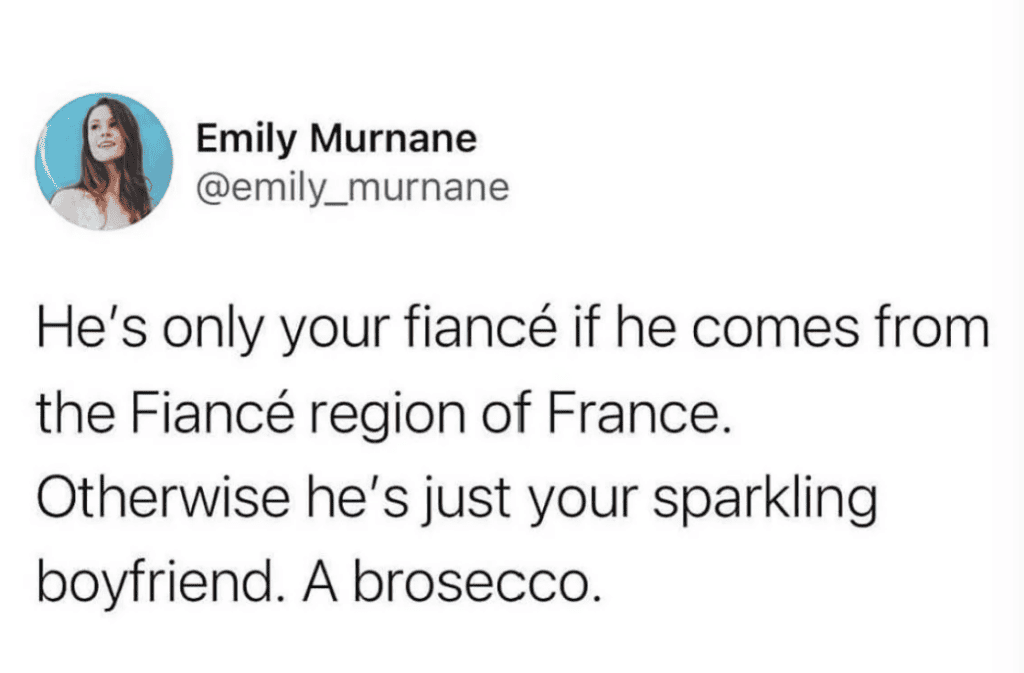
We’ve all heard that “unless it comes from the Champagne Region of France, it can only be called ‘sparkling wine.'” But why?
There is actually a law that protects real champagne grown in its unique soil and region from imposters. The Appellation d’Origine Contrôlée (the controlled designation by region) system is a French law that protects certain products based on their geographical origin. This legal system ensures that only products made within specific regions of France, using traditional methods of production, and with very specific characteristics, can be labeled with that region’s name. Otherwise, forbidden.

“Champagne” is one of these protected appellations (designations). To be labeled as “champagne,” a sparkling wine has to be:
- Produced in the Champagne region of France with its unique combination of climate, soil, and grape varieties that all contribute to the distinctive character and taste of champagne.
- Made from specific grape varieties – Pinot Noir, Chardonnay, and Pinot Meunier.
- Produced using the traditional methods include secondary fermentation in the bottle, which is what gives champagne its bubbles!
Besides Champagne, other famous French wines with AOC status include some you may know like Bordeaux, Burgundy, Côtes du Rhône, and Sancerre.
What Was the First Champagne?

The exact origin of champagne is a mystery, but it’s almost certain it involved a series of happy accidents and innovations over a period of time. The first sparkling wine appeared in the Champagne region during the 17th century.
To protect their wine from freezing, winemakers in the region would move it to underground cellars (many of which you can visit today!) where the temperature remained relatively constant. However, these cellars were not sealed tightly, and sometimes air would seep in, introducing oxygen into the wine.

And with oxygen around, the yeast in the wine would continue to ferment, eventually producing carbon dioxide gas. Then the gas would become trapped inside the wine, creating bubbles! But believe it or not, this was initially seen as a defect in the wine, because bubbles were thought to indicate a spoiled wine! My how times have changed!
Over time, people began to appreciate the uniqueness of this crazy sparkling wine. By the early 1700s, winemakers in Champagne produced sparkling wines on purpose, using techniques that actually encouraged the development of bubbles, and making thicker bottles that wouldn’t explode, and corks to safely contain the liquid which was under considerable pressure.
There is no other beverage today that evokes such luxury, and such a sense of joy and celebration as champagne. And there is no better place to discover its magic than the charming city of Epernay!
Fabulous Things to Do in Epernay
1. Stroll the Avenue de Champagne





The first thing you’ll want to do when you arrive in Epernay is to stroll the renowned Avenue de Champagne. As you can guess from the name, this avenue is home to many of the world’s most prestigious champagne houses. And they are all gorgeous.
What is a champagne house?
The champagne houses themselves are grand mansions usually having belonged to the wealthy wine merchants who wanted to flaunt their success. Today these houses, named after the winemakers have evolved to offer visitors the opportunity to tour their cellars, learn about the champagne-making process, and sample their exquisite champagne.
Why are all the champagne houses on the same street?
The Avenue of Champagne’s location right near the Marne River played a significant role in its development as a hub for champagne production. The Marne provided easy transportation, allowing the champagne to be exported efficiently. This location made practical sense – providing everything from the chalky soils of the vineyards, to the production, and shipping of the champagne.
Champagne Houses on the Avenue of Champagne
The Avenue of Champagne boasts an impressive lineup of champagne houses, so prepare to have your mind boggled. In just one kilometer you’ll pass by the houses of Moët & Chandon/Dom Pérignon, Champagne de Venoges, Pol Roger, Mumm, Perrier-Jouët, Taittinger, Mercier, Alfred Gratien, Boizel, Michel Gonet, Champagne De Castellane, Vranken, G.H. Martel, and more!
The champagne houses carry a massive inventory of champagne in their underground cellars that extend for 68 miles (110 km)! The champagne inventory totals more than 200 million bottles, so do the mental math and it’s not hard to figure out why this is called the most expensive avenue in the world!
2. Visit the Champagne, Wine, and Regional Archaeology Museum





When you’re planning things to do in Epernay, you may not be thinking of a museum visit, but think again! Save this little gem for when you need a break from the bubbly and want to spend an hour or two learning about the geology and archaeology of the region, the history of winemaking, and gawk at the breathtaking architecture and decor of the Perrier champagne house, which is now the home of the museum.
You’ll see everything from the limestone fossils found in the area, to exquisite bronze jewelry of the Celts, to Roman artifacts, and some interesting old wine making equipment. It’s really fascinating and well worth your time!
Hours vary seasonally, so be sure to check at the museum’s website for the most current hours and ticket prices.
3. Tour a Champagne Cellar


Touring a champagne cellar is the perfect introduction to champagne culture, which runs the gamut between the science of fermentation, political history, intriguing anecdotes, and the display of incredible artifacts.
It’s almost overwhelming, and hard to choose which one to visit! If you have a favorite champagne already, start there. If you don’t, the cellars of Moët & Chandon, and Mercier are guaranteed winners! I particularly loved Moët & Chandon, not only for the tour but because it’s my favorite champagne!
Cellars will offer standard group tours of about 20 people, small groups, or if you’re feeling splurgy you can have a private tour all to yourself.
And yes, there will be champagne at the end!
4. Do a Champagne Tasting

Tours of the cellars will generally end with a champagne tasting. One of the cellars will be set up with tables, and a serving station where you will enter to see poured glasses of champagne waiting for you and your group.
You will have the opportunity to taste and compare 2 or more glasses of champagne with an explanation and instructions from your guide. The cost will vary depending on the champagne. If your tasting involves “vintage” champagne it means that on a particular year, the tasters were so impressed with the extraordinary quality that they gave that year’s champagne this special designation, which means it costs more.
But you can also do champagne tastings in the tasting rooms above ground in the champagne houses themselves. Perrier-Jouët and Moët and Chandon have particularly nice tasting rooms.

5. Explore a Vineyard

If you’re not thrilled about going underground into the caves to learn about champagne production, this is the option for you! Or do both! You can book a lovely half-day tour from Epernay that will take you out into the Marne Valley where you can soak in the breathtaking views, and learn about grapes, vine tending, and champagne production from a knowledgeable guide. Moët & Chandon and other houses also offer vineyard tours to explore the terroir – the combination of soil, environment, and weather that makes champagne unique.
And yes, there will be champagne tasting afterwards! (There’s always champagne!)
6. Visit the Exquisite Gardens of the Hôtel de Ville
7 bis et 13, Avenue de Champagne
The Town Hall of Epernay (Hôtel de Ville), was originally the private 19th century mansion of the Auban-Moët family who were champagne merchants. The house, which is listed as a Historic Monument, features an impressive white marble World War 1 memorial on one side, and an absolutely stunning garden on the other.




There are several interesting and impressive rooms inside, including the City Council room, and a room rented out for weddings. But the garden is the real stunner. Mixing french and English landscape styles, with winding paths, ponds and waterfalls, sculptures, and a beautiful heart shaped feature. France has given it the designation “remarkable garden” – and it truly is.
We happened to catch a military band and celebration at the Hôtel de Ville when we were there!
7. Fly in the Captive Balloon
Esplanade Charles de Gaulle, Épernay

The ‘ballon captif’, or the captive balloon is one of the coolest things to do in Epernay, if you can! Unfortunately, limited hours of operation due to weather and wind means that it’s not a sure thing. But if you’re one of the lucky ones, you can soar up in the balloon which is firmly tethered to the ground, and get some absolutely epic views of the town, the Marne Valley, and the surrounding vineyards from the air! And you’ll get some stunning photos to boot!
The balloon is held securely by cables, and can take up to 30 passengers at a time to a height of almost 500 feet (150m)!
This is a perfect way for anyone nervous about going up in a free-floating hot air balloon to get all the feels of a balloon ride while staying firmly anchored to mother Earth!
8. Enjoy Free-Range Nibbles and Bubbles
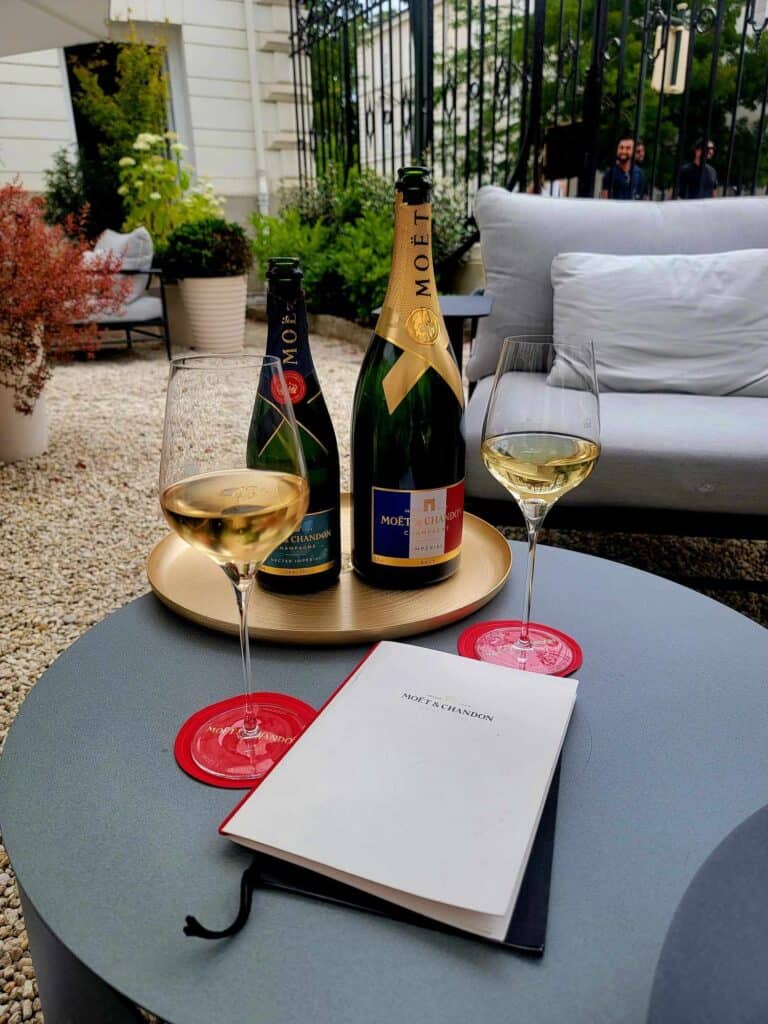


Outside the formal tours and tastings, the champagne houses on the Avenue de Champagne beckon you for spontaneous pop-ins where you can order champagne by the glass or bottle, and enjoy small bites.
We loved sitting in the courtyards of these amazing houses, and whiling away some time sipping, people watching, and engaging in conversation. Of all the things to do in Epernay, this one might just be my favorite. The relaxation and happiness is palpable in these places – after all, everyone is drinking champagne!
And you will not be rushed, so take your time and fully soak in the experience. Let all your senses celebrate. It’s like no other place.
9. Find Dom Pérignon & Friends


Just like back in the day when the houses were meant to draw attention and display the owner’s prestige, you’ll find many artworks and displays in the modern day that distinguish one house from another.
The mandatory instagrammable moment is the statue of Dom Pérignon (the Benedectine monk who is considered the father of champagne) which you will find outside the house of Moët and Chandon. But there’s also a fabulous statue of France’s King Louis XV in the courtyard of de Venoges where you can make yourself comfortable in the chair and have a toast. In 1728, it was Louis XV who authorized wines from the Champagne region to be sold and transported by the bottle, rather than by the barrel as had been customary. Allowing wine to be sold by the individual bottle made it possible to keep all those beautiful bubbles, and so boosted the production of champagne and assured that it was only from the region.
You’ll also find lots of other photo opps like polar bears and butterflies that various champagne houses use to secure those coveted social media posts.
Sponsored content: this section contains affiliate links
10. Discover the Eglise de Notre Dame

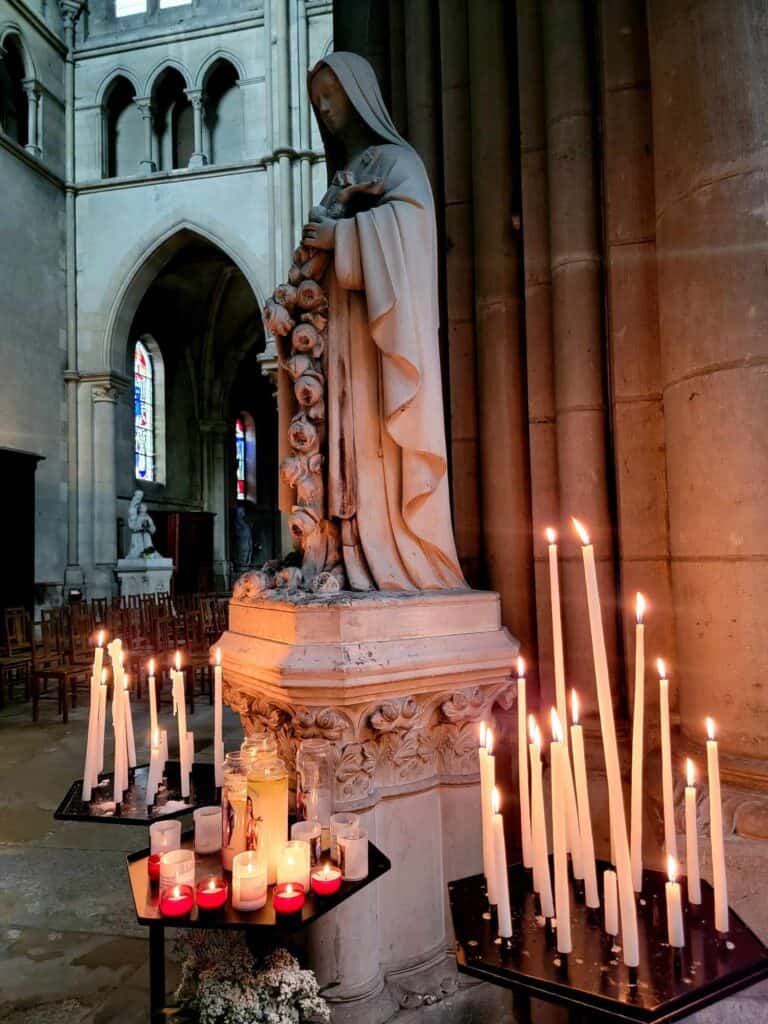


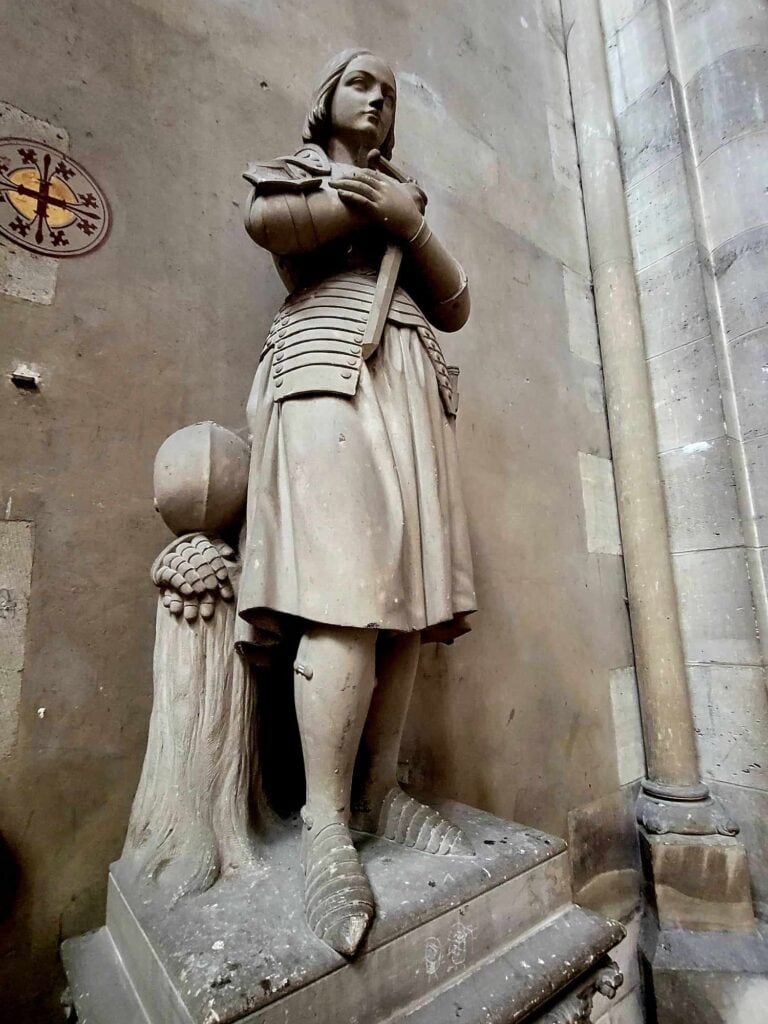

The construction of the church of Notre Dame d’Épernay spanned the years from 1898 to 1915, but only three years after completion it needed rebuilding thanks to German bombing in 1918.
It’s a beautiful church which definitely deserves a visit. It’s not as old as some, but it does contain some gorgeous 16th century stained glass, and several even older sculptures. All in all it’s a lovely quiet space right in the heart of the city that you should stop and visit.
We ducked inside during a rain shower and it was the beautiful, and peaceful moment we needed.
11. Celebrate the National Holiday at the White Soirée
This is about as special, romantic, and elegant as it gets! But, you have to be in Epernay on July 14th to be part of this once-a-year magic. That special date is “La Fête Nationale” or simply “le 14 juillet” in France, or as Americans know it, Bastille Day. The day commemorates the anniversary of the storming of the Bastille (a notorious state prison under the king) on July 14, 1789, during the French Revolution, and the ‘day of unity’ of the French people on 14 July 1790.
Our wedding anniversary also happens to be on July 14th, so we decided to spend it in the champagne capital – and it was all that and a glass of bubbles!

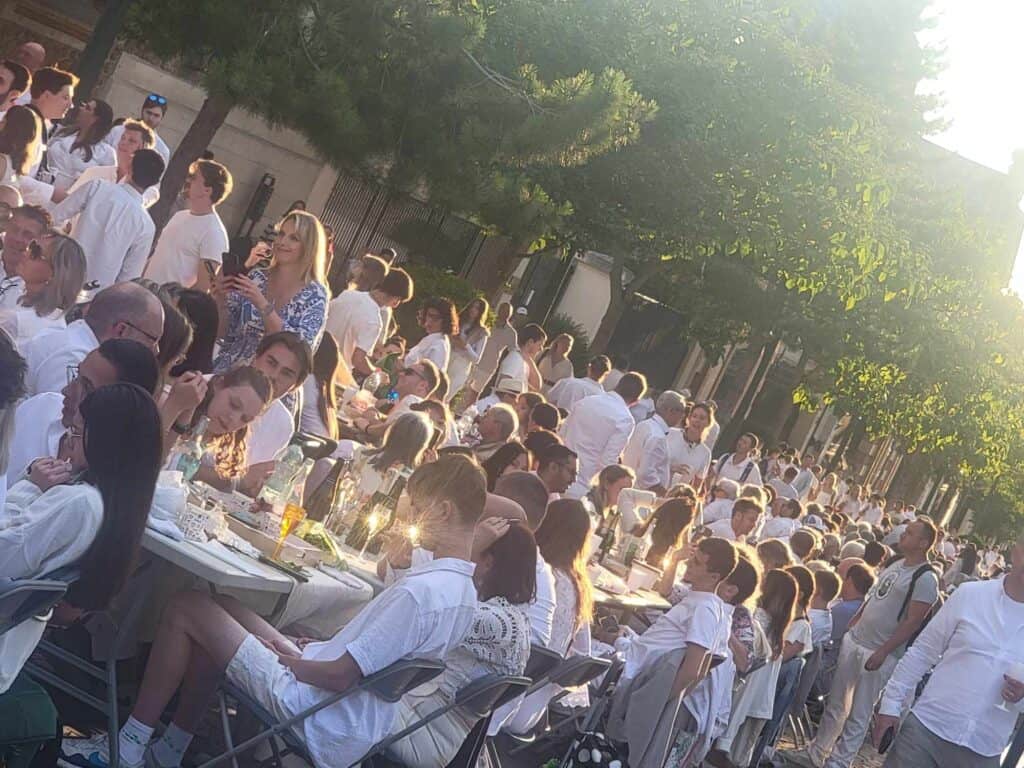



The entire city dresses in white, and gathers for the Soirée Blanc (the White Soirée), an incredible champagne picnic down the whole length of Champagne Avenue! You can either bring your own food and drink, or grab some amazing bites from food vendors or champagne houses along the way. The city of Epernay begins the set-up in the morning, lining the whole length of the avenue with tables and chairs. As the evening approaches, people bring charcuterie, snacks, hot dishes, and of course champagne! There are locals, families, couples, visitors, all there for the party. You can enjoy live music, dancing in the street, and champagne. The air is positively vibrating with ‘joie de vivre’!
The champagne houses stay open late and many have a set-up to sell champagne by the glass which you can take with you as you enjoy the evening.
If you’ve ever been to a European Christmas market, the champagne glass situation is the same as that of the hot mulled wine mug. You pay a few euros extra when you buy a glass, and then you’ll get it back when you return the glass. Or you can keep the glass as a memento. And of course, the glass is white. Guess which we did? A few euros was nothing for a unique souvenir that would remind us of that enchanted evening!
And when the evening begins to wind down, everyone walks to the end of the avenue for more music and fireworks!
Where to Stay in Epernay
There are a wide variety of amazing places to stay in Epernay. You can peruse them all – from small local B&Bs to villas on the Avenue de Champagne!
Our favorite spot is La Pétalerie – an unassuming but charming little B&B about a 10 minute walk from the Avenue. The owners are absolutely lovely, and they welcomed us and our frenchie, Helga like we were old friends. Our room was actually a little apartment, complete with kitchen and little eating and sitting areas. And a mini-fridge stuffed with champagne, of course!




When my rusty French failed me, they were quick with Google Translate, and provided us with information and advice about where to go and what to do. And the breakfast! Mon dieu! Picture the most beautiful, verdant, enchanted secret garden imaginable, with a big breakfast featuring coffee and croissants! It was a dream. You can even have champagne and charcuterie, or a selection of local cheeses in the garden in the evening.
We checked out before breakfast started on our last day, and they were kind enough to send us on our way with a little to-go bag of goodies. I can’t recommend this place enough if you’re lucky enough to get it!
If you’re looking for super-fancy there are plenty of places, but this felt warm and welcoming and just what we wanted. Charmant!
Where to Eat in Epernay
It’s hard to find bad food in France, and especially hard to find it in Epernay! If you are looking for the cream of the crop, there’s no better place to go than the guide to Michelin recommended restaurants of which there are 20 in Epernay!
It pays to scout ahead and make reservations during the summer because restaurants will definitely fill up. If you haven’t done that, try to be there for the first seating, or just try your luck. You may have to hit up a couple restaurants, but you’ll eventually find a spot. And you really can’t go wrong with the food.
How to Get to Epernay
Epernay is a very walkable city with most of the main attractions located on or very close to the Avenue de Champagne. Here are the most convenient ways to get to Epernay!
🚗 Epernay by Car
There is lots of parking in designated parking lots, and on the street. Almost all of the lots are open 24 hours, and are located near the beginning of the Avenue de Champagne which is marked on the map below in purple.

- Paris: About 1 hour 36 minutes by car
- Reims: About 30 minutes by car
- Luxembourg: About 2 hours 26 minutes by car
- Brussels: About 2 hours 52 minutes by car
- Kaiserslautern: About 3 hours 10 minutes by car
🚉 Epernay by Train
The train station is only about a 5 minute walk from the city center area.
- Paris: About 1 hour 25 minutes with 1 change
- Reims: About 34 minutes direct
- Luxembourg: About 3 hours 14 minutes with 1 change
- Brussels: About 3 hours 13 minutes with 1 change
- Kaiserslautern: About 4 hours 30 minutes with 3 changes
✈️ Epernay by Plane
The closest airports to Epernay are:
- Paris Charles de Gaulle (CDG) 63 miles (101.3 km)
- Paris Orly (ORY) 75 miles (121.3 km)
- Charleroi (CRL) 101 miles (163.2 km)
🥂 Here’s to a great time in Epernay!
I hope this overview has given you a good idea of all the amazing things to do in Epernay that await you! I absolutely love Epernay because it gives such a unique mix of experiences – history, geology, science, viticulture, natural beauty, history, luxury, gastronomy, relaxation, and education all in one.
There’s nowhere else in the world that duplicates the experience you will have in Epernay, so dive in and enjoy. Cheers!
You May Also Enjoy:
- Hack the Louvre! How to See the Louvre in 3 Hours
- Napoleon’s Tomb is Definitely Not What You’re Expecting
- 10 Best Things to Do in Reims France
- 12 Incredible Things to See in Metz, France
- What to Expect at the New Museum of Urban and Street Art in Bitche
- Is Versailles Worth It? Bastille Day in France
- Best 2 Day Dordogne Prehistory Itinerary: What to See & Do
- The Sons of Bitche (France) and an Epic ‘Then and Now’ Photo Op!
More City Guides to Europe’s Hidden Gems!
- 46 Best Things to Do in Rothenburg ob der Tauber
- One Day in Bamberg: Best Guide to Germany’s Medieval Beer Capital
- 21 Best Things to Do in Kaiserslautern Germany
- 11 Best Things to Do in Trier, Germany
- One Day in Aachen? Discover the Treasure!
- 11 Best Things to Do in Marburg, Germany’s Fairytale Town
- The Perfect Weekend in Cologne, Germany
- 12 Incredible Things to See in Metz, France
- Ostuni the White City: Your Magical Gateway to Puglia
- The 7 Most Amazing Things to Do in Ravello Italy
- Is Pisa Worth Visiting? The Good and the Bad.
- Ravenna, Italy – Ultimate One-Day Itinerary!
- 10 Best Things to Do in Reims France
- 20 Amazing Things to Do in Poznan, Poland!
- Altdorf Switzerland: Discover Where William Tell Shot the Legendary Apple
